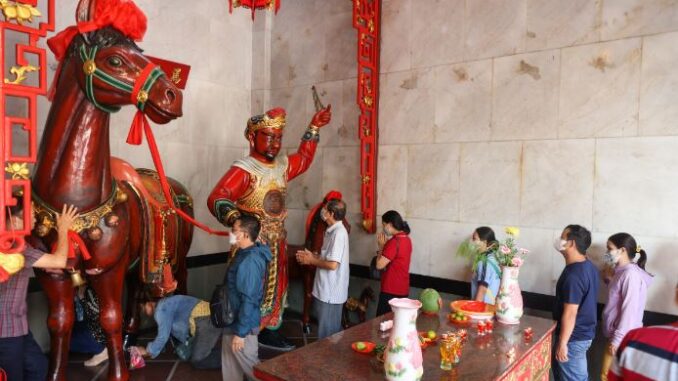
HO CHI MINH CITY – Two days before the Lunar New Year, many people come to Ong Pagoda (District 5) to worship and go through the belly of the horse statue to pray for luck and fortune.

On the morning of February 3 (January 13), many Chinese people in the Cho Lon area and tourists flocked to Ong Pagoda to worship Quan Thanh De Quan, wishing for luck and blessings in the new year.
Ong Pagoda, also known as Quan De Temple or Nghia An Assembly Hall, is the assembly hall of the Trieu Chau and Ha people who came to Vietnam to live, built around the beginning of the 19th century. The temple worships Quan Cong (or Quan Thanh De Quan). a character of the Three Kingdoms period with a loyal heart and heroic spirit.
Quan Thanh De Quan’s day at the temple takes place on January 13 and June 24 of the lunar calendar. According to the concept, this is the birthday and sainthood of Quan Cong, so they are also the two most important worshiping ceremonies of the assembly in the year.

In the center of the main hall, there is a space to worship Quan Thanh De Quan, which is the most important area of the temple. When coming here, all pilgrims leave their shoes outside to come in to offer offerings (cake, fruit, roast meat, oil…) and kneel before the statue of Quan Cong.

The pagoda also has a shrine dedicated to the horse Xich Tho, the steed of Quan Cong. After burning incense at all the shrines, the worshipers wait in line to get through the belly of the wooden horse.

According to folklore, men go into the belly of a Xich Tho horse 7 times, a woman 9 times will have a lot of luck and blessings in the new year. Therefore, during Tet and the full moon day, there are many visitors to the temple. Mr. A Quang, 65 years old, living in District 5 said.

After going through all the rounds, the worshipers also ring the bell in front of the horse’s neck or stroke the horse’s neck. The Chinese believe that the echoing jingle will bring good luck throughout the year to the person who rings the bell with their own hands.

In addition to crawling through the horse’s belly, many guests also bowed and stroked the statue of Ma Thau General Quan (or Ma Tou General Quan) who used to take care of Quan Cong’s horse.

Hoang Son, 27 years old, captured the moment his family crawled over the horse’s belly to pray for peace. From Bac Lieu to offer incense to Ong Pagoda, the young man said that this was the first time the whole family performed the ritual. “I have known this custom for a long time, so now I have the opportunity to visit the ceremony. For the Chinese, this temple is very sacred, everyone wants to visit at the beginning of the year,” Son said.

Many other Chinese in Ho Chi Minh City come to the temple on the day of the astral to bring the statue of Quan Cong to the church. Mr. Tran Thanh Huu, District 5, brought a full set of three holy statues including: Quan Cong, Quan Binh and Chau Xuong to the ceremony.
“Everyone who comes to visit the statue must bring a full set of clothes and then offer the ceremony at the main hall where Quan Thanh De Quan is worshiped, so that the worship will be sacred,” said the 42-year-old man.

Near noon, visitors to Ong Pagoda were more crowded. Because the temple limits burning incense inside to avoid stuffiness, many people use flower branches instead of lamps.

After worshiping all the shrines, people ask for tattoos in Ong Pagoda with the belief that they will receive the protection and blessing of the gods.

Like most temples of the Chinese, Ong Pagoda has an overall architecture in the shape of a word. The work includes items such as electricity money, Thien Quang courtyard, incense house, main hall and assembly hall along both sides of the shrines.
With an area of about 4,000 m2, the pagoda is a tourist attraction in Ho Chi Minh City. In 1993, the work was recognized as a national architectural and artistic monument.
( According to vnexpress )
